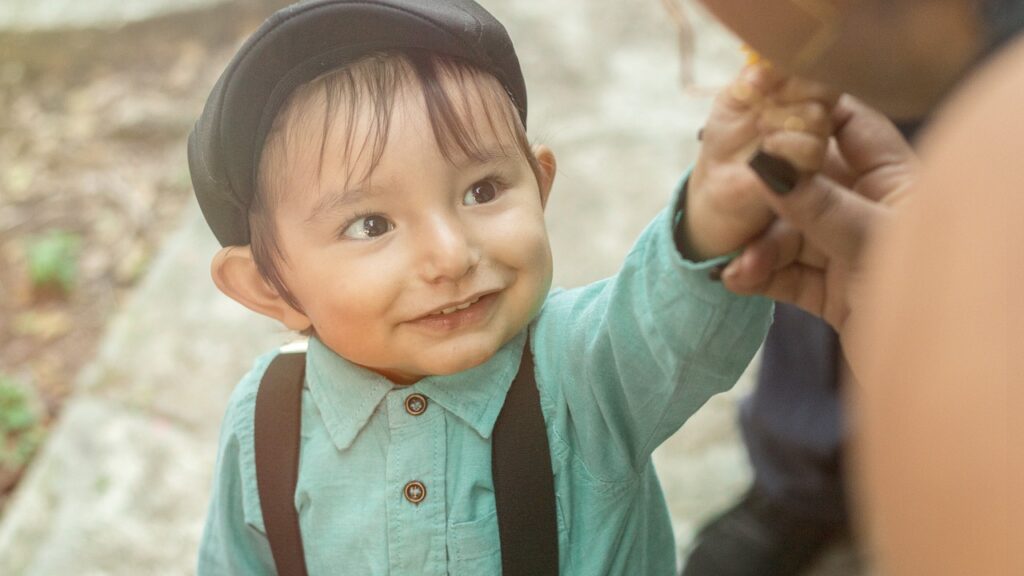Have you ever found yourself at a loss for words when a child looks up at you expectantly, waiting for you to strike up a conversation? You’re not alone. Many adults find themselves defaulting to the dreaded ‘So how’s school?’ without even realizing it. But why do we struggle to communicate with kids when we were all children once? According to Tina Payne Bryson, a psychotherapist and co-author of The Whole-Brain Child, the issue lies in our disconnect from childhood. ‘We forget what it’s like to be a child,’ Bryson explains. Our adult lives are vastly different from those of children, and our brains and habits have evolved, making it challenging to relate to a 10-year-old’s world.
But fear not, because the secret to breaking the ice with kids isn’t about dredging up your own childhood memories. It’s about seeing them as individuals with their own interests, insights, and personalities. When you approach a child with curiosity, warmth, and sincerity, you’re on your way to making a new little buddy and shedding that awkward adult skin.
Finding common ground is your first mission. Whether you’re at a family barbecue or a park picnic, an open-ended question can kickstart a conversation. Take a cue from Ben R., an 11-year-old from Highland Ranch, Colorado, who suggests asking about something you enjoy. Are you a gamer? Ask them about their favorite video games. A bookworm? Inquire about the book they’re currently hooked on.
The way you frame your questions can make or break the interaction. Robyn Silverman, host of the podcast How to Talk to Kids About Anything, advises against yes-or-no questions. They’re conversation stoppers. Instead, get creative. Instead of the mundane ‘How’s school?’, why not ask, ‘If you were principal for the day, what’s one thing you’d change?’ It’s about sparking a dialogue that’s more than just ‘fine.’
Once you’ve found that point of connection, whether it’s a mutual love for a game like Codenames or a playful debate over the merits of dipping fries in milkshakes, the conversation can flow more naturally. Ben points out that discovering common interests can help both parties relax and focus on the connection.
But how do you keep the conversation going? The key is to listen—really listen. Many adults falter here, either by dominating the conversation with their own stories or by tossing in random comments that derail the discussion. Ben recalls an awkward encounter with an adult who didn’t seem to pay full attention to their chat, making the experience uncomfortable. Instead, practice active listening. Show genuine interest in what the child has to say and ask relevant follow-up questions. Morgan Eldridge, a clinical psychologist, suggests treating the child as the expert on their passions. If they’re into Pokémon cards and you’re clueless, ask them to enlighten you.
Your body language and tone are also crucial components of active listening. Get down to eye level with younger kids, put away distractions, and maintain eye contact. And remember, kids are more sophisticated than we often give them credit for—there’s no need for baby talk.

As the conversation progresses, let the child’s enthusiasm guide you. Adults tend to be logical and solution-oriented, but kids thrive in the realm of play and imagination. Don’t be afraid to ask whimsical questions or to follow the child’s lead into a world of silly speculation. And whatever you do, never belittle their interests. If they’re passionate about something, even if it’s not your cup of tea, encourage them to share.
If you stumble and find yourself dominating the conversation or getting distracted, apologize and steer the conversation back to them. It’s about creating a safe, friendly, and respectful environment where the child feels seen and heard.
Kids come in all temperaments, just like adults. You don’t have to be the life of the party to connect with a child. Be yourself, whether you’re outgoing or shy. Kids understand nervousness and appreciate authenticity. If you’re on the shyer side, Ben offers a tip: when in doubt, ask a question. It takes the focus off you and allows you to learn more about the child.
Sometimes, a child may be anxious about talking to an adult. In these instances, it’s important to project warmth and safety. Sharing a personal, slightly embarrassing story can break down barriers and make you more relatable. And if the child prefers quiet, respect that. Not every moment needs to be filled with chatter.
In essence, talking to kids is not so different from talking to adults. It’s about finding shared interests, asking thoughtful questions, and being a good listener. With these tips in mind, you can turn a potentially awkward encounter into a delightful exchange that might just blossom into a genuine friendship.
Now that we’ve explored why adults often fumble when talking to kids and how to initiate a conversation, let’s delve into the art of keeping that dialogue engaging and meaningful. Engaging children in conversation is not just about asking questions; it’s about creating an experience that is enjoyable for both parties involved. Here are some tips and tricks to help you master the art of conversing with kids.
Embrace the power of storytelling. Children are naturally drawn to stories, and this can be a fantastic way to connect with them. Share anecdotes from your own life that are relatable and age-appropriate. This not only entertains them but also gives them a glimpse into your world. Remember, the stories don’t have to be grandiose; often, it’s the small, personal tales that capture a child’s imagination the most.
Let’s talk about the importance of humor. Kids love to laugh, and sharing a joke or a funny observation can be a great icebreaker. It shows that you don’t take yourself too seriously and that you’re open to having fun. However, be mindful of the child’s age and ensure that your humor is appropriate. A well-timed, silly pun can work wonders in lightening the mood and making a child feel at ease.
Another key aspect is to encourage creativity and imagination. Ask questions that prompt them to think outside the box, such as ‘If you could invent a new ice cream flavor, what would it be?’ or ‘What would you do if you could fly for a day?’ These kinds of questions stimulate their creativity and allow them to share their unique perspectives with you.
It’s also essential to be patient and give the child time to respond. Sometimes kids need a moment to think about their answers, and that’s okay. Don’t rush them or fill the silence with your own words. This patience shows that you value what they have to say and are willing to wait for their contribution to the conversation.
Active listening is important when communicating with anyone, even children. Show that you are engaged by nodding, smiling, and giving verbal cues that you are following along. This encourages them to continue sharing and shows that you are genuinely interested in what they have to say.
Keep the conversation balanced. While it’s important to ask questions and listen, it’s also okay to share about yourself. This can help the child see you as a person, not just an adult, and can lead to a more reciprocal and natural conversation. Share your interests and experiences that might resonate with them, and you might find that you have more in common than you thought.
When the talk slows, don’t drag it out. It’s perfectly fine for conversations to have a natural end. If you sense that the child is ready to move on to something else, respect that. You can always pick up the conversation another time.
Don’t forget to follow up on previous conversations. If a child told you about a test they were nervous about, ask them how it went the next time you see them. This shows that you were listening and that you care about what’s happening in their life.
Talking to kids doesn’t have to be a daunting task. With a little bit of preparation and a willingness to step into their world, you can have meaningful and enjoyable conversations with the younger generation. Remember to be yourself, be patient, and most importantly, have fun with it. After all, the connections you make with kids today can turn into cherished relationships that last a lifetime.
Related posts:
How to (actually) talk to kids





